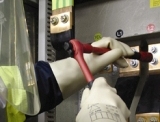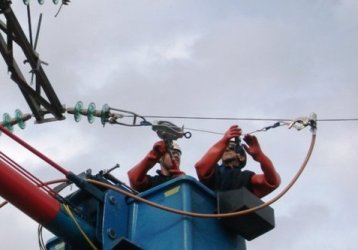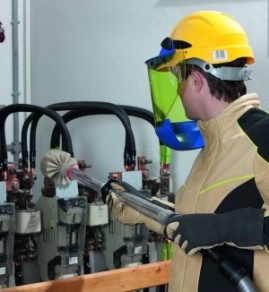Carrying out live work in electrical installations of different voltage classes: methods, means of protection
 Emergency situations often arise when it is necessary to remove a part of an electrical installation, electrical network for repair in order to eliminate the malfunction, but for certain reasons this cannot be done. For example, a broken contact connection is detected on a 750 kV line.
Emergency situations often arise when it is necessary to remove a part of an electrical installation, electrical network for repair in order to eliminate the malfunction, but for certain reasons this cannot be done. For example, a broken contact connection is detected on a 750 kV line.
This line is very critical and can supply a significant part of the power system in several regions of the country. If it is not possible to power the power system from the backup line at the moment, then the only possibility to eliminate the malfunction is to carry out live work, that is, without first disconnecting the power line.
Also, working under voltage in electrical installations is considered one of the modern methods of maintaining electrical installations. Locking sections of electrical installations, in particular overhead power lines This is quite a labor-intensive process, especially if it is a very important highway line, the interruption of which cannot be coordinated within a year.
In this case, carrying out repairs or maintenance without de-energizing significantly saves the time needed to coordinate the work performed and take measures to bring the power line into repair.

Consider methods of operation at the operating voltage of the electrical installation and appropriate means of protecting operating personnel from electric shock appropriate for each method.
The first method is to work directly on the potential of a live wire, while the face is reliably isolated from earth. The technology of working under tension ensures the work of a person standing on an isolated stand, isolated from the working platform of a mobile crane. At the same time, the person is in a special protective set of clothing. Before the ascent to live parts begins, the worker's protective suit is attached to the isolated work platform.
Electric voltage — that's it potential difference… Therefore, to avoid electric shock, before starting work it is necessary to equalize the potential of the shielding assembly and the working platform with live parts that are live. To equalize the potential, the isolated working platform is connected to the live part (conductor, bus) through a flexible copper wire, which is fixed with an insulating rod using a special clamp.
Grounded parts of metal structures, supports have a potential that is different from the potential of live parts, approaching them leads to an electric shock to a person.Therefore, in order to ensure safety when working below the potential of the conductor, one should not approach the earthed parts closer than the permissible distance value, which is determined for a given line voltage class.
For example, if working on a line with a voltage of 330 kV, then a person working under the potential of the conductor is prohibited from approaching the metal structures of the supports at a distance of less than 2.5 m.
In connection with the increased danger when performing work using this method, workers must undergo specialized training, a knowledge check on the method of performing work under tension. Instructions are drawn up for each type of work, and special technological maps are drawn up when planning work.
The second method is to work with the isolation of a person from live parts without isolating a person from the ground... Work according to this method is carried out using insulating electrical protective equipment, which is selected in accordance with the nature of the work performed and the class of the voltage of the electrical installation.

There are electrical safety devices with a voltage of up to and above 1000 V, which in turn are divided into basic and additional.
The main protective equipment protects a person from the action of electric voltage and arc, they allow you to work for a long time under the working voltage at the place of electrical installation.
Additional protective equipment does not allow operation at working voltage, they are additional protection of the main electrical protective equipment that allows you to protect the worker from step voltage and the touch voltage.
This method of carrying out live work is the most common in electrical installations. An example is checking the presence of voltage in the line or checking the operability of the voltage indicator in electrical installations with voltages above 1000 V. The voltage indicator itself is the main electrical protective device. A voltage indicator above 1000 V should be used dielectric gloves — in this case they act as an additional electrical protective device.
The third method provides for the isolation of the person performing the work both from the ground and from the live parts of the electrical installation that are under working voltage. The most common example is work in electric circuits up to 1000 V: switchboards, relay protection cabinets and equipment for automation of electrical installations.
In this case, to ensure the safety of the person in connection with electric shock, electrical safety devices are used. To isolate a person from live parts, dielectric gloves and tools with insulating handles are used (screwdrivers, pliers, pliers, electrician's knives, an electrician's knife for breaking a cable, etc.) - these protective means in electrical installations with a voltage of up to 1000 V belong to the group of the main electrical protective means ... To isolate a person from the ground, additional protective means are used - a dielectric pad or an insulating support.
